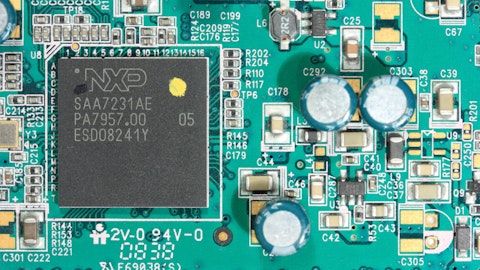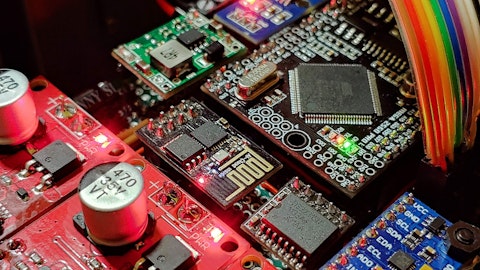Tom Diffely: Great. I appreciate all the extra color.
Gayn Erickson: Thanks, Tom.
Operator: Thank you. The next question is coming from Matt Smith from Halter Ferguson. Matt, your line is live.
Matt Smith: Yes, thanks. And Gayn, I wanted to kind of piggyback on that last question, I mean hearing everything you’ve talked about in the longer term kind of prospects around GaN or photonics or even newer markets within auto, am I right to presume that your kind of level of expectation for [Technical Difficulty]
Gayn Erickson: Matt, you just broke up on your last sentence. Our level of expectation what?
Matt Smith: Sorry. Apologies. Can you hear me now? Is that any better?
Gayn Erickson: Yes.
Matt Smith: All right. Just your level of expectation around some of these, either new markets or new segments seems to be increasing relative to maybe what you would have thought a couple of years ago or maybe even a couple of quarters ago. So despite the kind of short-term noise or like a demand we might be seeing on auto, is your expectation on the other segments kind of increasing to the point where you think you might be close to the capacity in a couple of years?
Gayn Erickson: Yes. Okay. So yes, let me — kind of the historical perspective of the timing of it. I’ll pick on what do I do, memory, because we didn’t talk much at all about memory. What we’ve said is, if you invest in area, you are investing in memory. Memory has always been on our plans and we have different level of engagements and we’re still talking with memory suppliers about potentially wafer-level burn-in. It is not deployed in mass yet, it makes sense at flash, it ultimately makes sense in DRAM. That’s the longest term out there. We’re not planning to get revenue in the next year. But I’ve even shared, we have specific long-term bonus and KBOs for every manager and my staff and myself to get into memory. So that is a real thing.
Back up a little bit, it’s gallium nitride. We just talked about gallium nitride just like within the last nine months and what we said at the beginning of the year is, we’re getting — we’re going to work to engage with the leaders, which now I’m very comfortable we are, to understand the requirements and what their needs are, and — so we can be there to address their needs and to learn and understand if there is a large production opportunity. What I will share with you is that, we’ve learned a lot already together with those customers. There is some things about it and I’m not going to get into it [indiscernible] but there is some real tricks that we’ve been able to help our customers to solve that are unique to GaN versus silicon carbide.
And honestly, I’m super happy about it, I am a bit of a technical nerd, but the things that we’re able to do with the customers are really impressive and that’s great and puts us in a very good comfortable position to be able to be there. There is data that is now supporting the need for production burn-in. We are still getting our arms around how big that is and so we haven’t put out any actual numbers. But I do believe much more confidently now than two quarters ago that there will be production business for us versus before it’s more of an investigation. Okay? And then the one prior to that would be — another one was silicon photonics. The first time I talked about silicon photonics IO was December of 2022. So it’s only been a little bit of a year ago.
And at that time, I mentioned that early indications from the likes of an Intel had actually started to talk about it in demos on their website they would — Pat Gelsinger was giving up and talking about this. And it’s like boy, something sure seems like they are brewing around that. And people said, what do you think? And my question was, listen, that would be fantastic and it makes sense, because it has all the same needs. It needs burn-in. It’s a compound semiconductor, both for reliability and stabilization. Its application is a multichip module, meaning, you’d want to do it at die level, because if you put it in with a graphics processor or a central processor or something else, you don’t want that device being thrown away if this one fails.
Okay? The early indicators where we had gotten some NP engineering and then we got a production order last May, and people asked, what did you think? I said, I was surprised. That seems sooner than expected. That’s the one we’re working on to ship this quarter by next month. Okay? So we’re now seeing more visibility of that. And candidly, and I don’t want to get too carried away on this AI thing, but the people are out — Nvidia and AMD and intel have been talking about one of the big problems with these AI processors is their chip-to-chip bandwidth, or they can talk internally to the die that are inside, but even that’s at a bandwidth limitation. So each of those have talked about how do I actually integrate an optical interface to be able to overcome the bandwidth limitations of an electrical interface?
And TSMC and global foundries have been making big investments to be able to help them with that, or the IDMS’ of the world, like an intel would be doing it themselves and AMD[ph] somewhere in between. So what we think is, that looks like a really interesting opportunity and it’s right up our path, because what we do there is candidly even more unique than even the silicon carbide because of the power. The interesting thing is, if you walk up and look at it, it looks like the same system that we’re shipping to silicon carbide. But instead of high voltage, we’re talking about high power, in this case, lower voltage and a lot of current. And so, with — the mix and match of the platform allows us to do that. So this is actually just a reconfiguration of the same system that we were shipping to the likes of silicon photonics customers and 2D, 3D sensors like on the facial recognition on mobile phones, it’s the same one but even higher power than that.
So I’m still not clear. I would tell you, people’s roadmaps are really close to their chest. This is not something you’re going to publicly read about how big the market is going to be. One of these days, you’re just going to see one of those big suppliers show up with the product and that’s where the market is going to come from. So, some of the stuff we’re doing the hardest thing is, you can’t go out and read about how big the market is going to be because it didn’t even exist beforehand. So anyhow, those are some of the other markets that we’re doing. I hope that gave you probably more color than you are even looking for.
Matt Smith: I think what I was trying to get at is, it seems to me that the growth rate of these, let’s call it, non-core business segments for Aehr today, it’s probably going to be like higher than the growth rate within the kind of core automotive silicon carbide market. Is that kind of how you would think about just the sheer quantity and the sheer magnitude of those opportunities?





